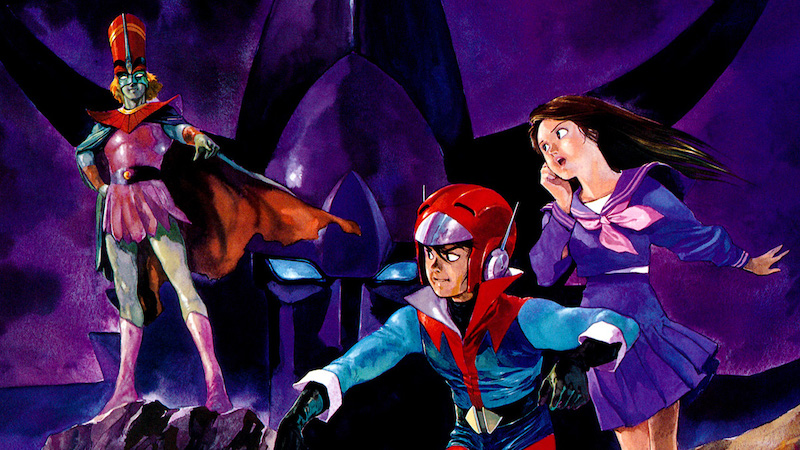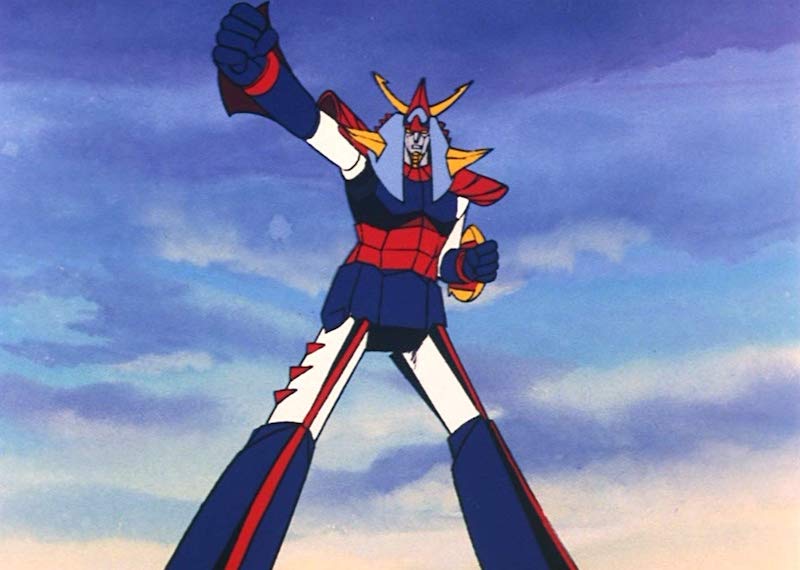Yuusha Raideen ran from April 1975 to March 1976 on Japanese television and had 50 episodes. It is well remembered in Japan almost 50 years later and after watching it I can understand why. It had everything a super robot show needed to appeal to a large audience plus better attention to story than most in the 70s.

The show was so popular it has had imitators and remakes. Chouja Raideen (1996) wasn’t a true remake but it certainly tried to cash in on name recognition. RahXephon (2002) was an unofficial remake. Chief director and creator Izubuchi Yutaka stated in an interview he was basically making a modern Raideen. Raideen (2007) was the official remake. That show wasn’t a good offering so I was pleased to discover the original was available from fansubbers. At least three different fansub groups cooperated on the show. Quality level varied greatly. For two episodes the subtitles wouldn’t display so I had to open the source file and read along while the episode played.
The spelling of the show has been a point of confusion for years. English speakers usually spell it Reideen but a look at the Japanese titles makes it clear “ray – deen” isn’t it. It is pronounced “rye – deen” so I use Raideen.
1975 gave us a lot of super robot shows but Raideen stood out not only for its quality but also its different approach. Unlike Kotetsu Jeeg, when Raideen tried something different from the crowd it got it right. Where the other super robot shows featured advanced technology, Raideen offered the mystical qualities of the lost civilization of Mu. In the process they neatly dodged the question that plagues many super robot shows: if the enemies are so fearsome, why not build a few more of that super robot? In Raideen no one in modern times can build a giant robot. To heighten the otherworldly qualities, the opponents Raideen battles employ monster sound effects from Toho’s Godzilla movies.

The voice actor for Prince Sharkeen was brilliant. Sharkeen was the main villain for the first half of the show and is featured in most promotional images of the show today. His gung-ho, hot-blooded princely voice made the character dominate every scene in which he appeared.
Zambot 3 (1977) featured alien invaders who built each episode’s opponent from a scrap heap that was zapped before gelling into a fearsome robot. I now know this was taken from Raideen where the start of many episodes showed us a pile of rocks blessed by the priest of the Demon Empire and then zapped by energy from the statue of demon lord Barao.
Raideen didn’t take any risks with its color scheme. It stuck to the tried-and-true red, white and blue with yellow trim. This color scheme was common in the super robot shows of the 70s and we shouldn’t be surprised it made it into the Gundam franchise. A dramatic rush through tunnels or tubes to enter the giant robot before a fight was a mainstay of the 70s super robot shows. Raideen featured Akira riding his motorcycle to the rocky outcrop where Raideen was stored so he could make a heroic leap and get caught in midair by Raideen’s energy beam. Not even Go Nagai could top that.
The supporting characters were very well done. 1975 had several support craft for super robots. Jeeg had a jet that carried its parts to the battlefield. The Getter Robo team had a command/reconnaissance craft. Raideen had the Beluga (or Blue Gar, depending on the team writing the subtitles) that fought alongside. It was piloted by Jinguji, a badass who at times threatened to outshine the hero of the show. Rather that a single genius scientist to support the hero Akira had four. His father, grandfather, an electronics expert and another scientist. This team of scientists and experts made the operation supporting the hero much easier to believe.
As is the case of many super robot shows, I had to wonder why the Japanese government never made an appearance to ask questions. Also, why did the Raideen team never go on the offensive and try to discover the Demon Empire’s secret base?
Some super robot shows did a good job of portraying a central theme. Getter Robo emphasized sacrificing one’s ego to work with others as a team. Raideen had no central theme that I could find but it didn’t reduce my enjoyment of the show. It certainly made up for that lack with great story writing. Compared to other mecha shows of the 70s, Raideen had superior writing. Mazinger Z or Getter Robo could mix up the order of the episodes with no real loss. Raideen had many plot points that unfolded slowly through the episodes. The resolution of the show was a satisfying drama that unfolded over the course of more than five episodes.
Raideen is a super robot that no anime fan should miss. I wish a fan subbing group with more polish would clean up the subtitles and make sure they display for every episode. A blu ray release for North American would definitely earn my dollars.







Leave a Reply